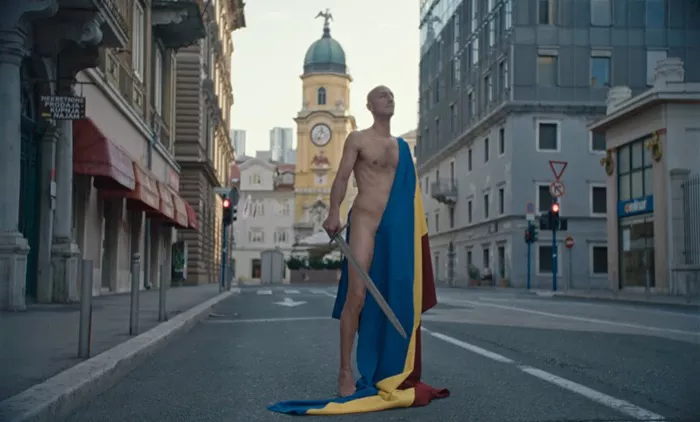In an era when fascist ideologies are on the rise in certain parts of the world, Igor Bezinović’s inventive documentary Fiume o Morto! offers a timely reminder of how quickly even the most flamboyant and oppressive dictators fade into obscurity. The subject of Bezinović’s film is Gabriele D’Annunzio, the Italian poet and army officer who, in 1919, led a brief and absurd occupation of Fiume (now Rijeka) and declared it the Italian Regency of Carnaro — an independent city-state with himself as its self-appointed Duce.
Bezinović’s documentary takes a humorous yet pointed approach to this historical episode, involving over 300 local residents in Rijeka to reenact D’Annunzio’s short-lived reign with an unmistakable lack of reverence. The result is an engaging and comedic hybrid that recalls Robert Greene’s Bisbee ’17, though Fiume o Morto! leans further into farce. Beneath the humor, Bezinović, a Croatian filmmaker, contemplates D’Annunzio’s legacy on both sides of the Italo-Croatian border, raising questions about how failed despots are either glorified or forgotten in the long term.
The film’s title, a sardonic reference to D’Annunzio’s military slogan “Fiume or death!”, sets the tone for a documentary that critically explores how the past is shaped by successive generations. Through the lens of Rijeka’s complex history, the film looks at how political and geographical boundaries continue to influence contemporary perceptions of historical figures.
Bezinović starts by humorously summarizing Rijeka’s troubled past with Italy, including images of reclaimed landmarks like the Street of Victims of Fascism (formerly Via Roma). He even cheekily references his colleagues’ advice to avoid too much focus on fascism, hinting at the sensitivities surrounding such topics. The documentary moves on to feature street interviews with the city’s residents, particularly younger generations, many of whom are either unaware of or indifferent to D’Annunzio’s occupation of their city. Others offer varying degrees of sympathy for the man, from dismissive calls of “fascist” to more nuanced views that acknowledge his talents as a poet and lover.
In typical documentary fashion, these interviews double as casting sessions, with Bezinović inviting locals to participate in the dramatization of D’Annunzio’s fateful mission. Participants are selected for their physical resemblance to the dictator or for their language skills, as seen in a poignant exchange with a speaker of the old Venetian dialect, which once thrived in the city. A musician, who looks more like an anarchist than a soldier, even volunteers to portray one of D’Annunzio’s men. The casting process itself becomes a playful exploration of historical interpretation.
The reenactments, shot on location in Rijeka, use a mix of amateur actors, period costumes, and a rich archive of over 10,000 photographs taken by D’Annunzio himself. These visuals aim to recreate key moments of his occupation, such as his journey to the city and his eventual defeat after a failed military campaign. However, the documentary’s deliberately low-budget production highlights the gap between past and present, with humorous anachronisms underscoring the absurdity of D’Annunzio’s ambition. In one scene, his grand speeches are delivered to a sparse audience of only two, and a rowdy scene on a bridge takes on a farcical tone.
Despite its intentionally imperfect restaging, Fiume o Morto! immerses the viewer in the historical moment, especially in a gripping recreation of the five-day “Bloody Christmas” battle that saw D’Annunzio’s humiliating retreat. The film ends with a return to the contemporary, Croatian-accented Rijeka, where few remnants of D’Annunzio’s occupation remain. In contrast, a statue erected in nearby Trieste commemorates the centenary of his failed regime, offering a sharp commentary on how history is often written by the victors.
Bezinović’s Fiume o Morto! is a thought-provoking yet entertaining exploration of the past, celebrating Rijeka’s rich, diverse identity while simultaneously critiquing how history is remembered and distorted over time. After winning top honors at the Rotterdam Film Festival, Bezinović’s documentary is sure to make waves at international festivals and resonate with arthouse audiences.
Related topic:
Romero’s ‘Land of the Dead’ Delivers Thrills and Social Commentary
“Raptures” Explores the Rise of a Cult Leader in 1930s Sweden
Magenta Light Acquires Domestic Rights to Deep Water for Theatrical Release

